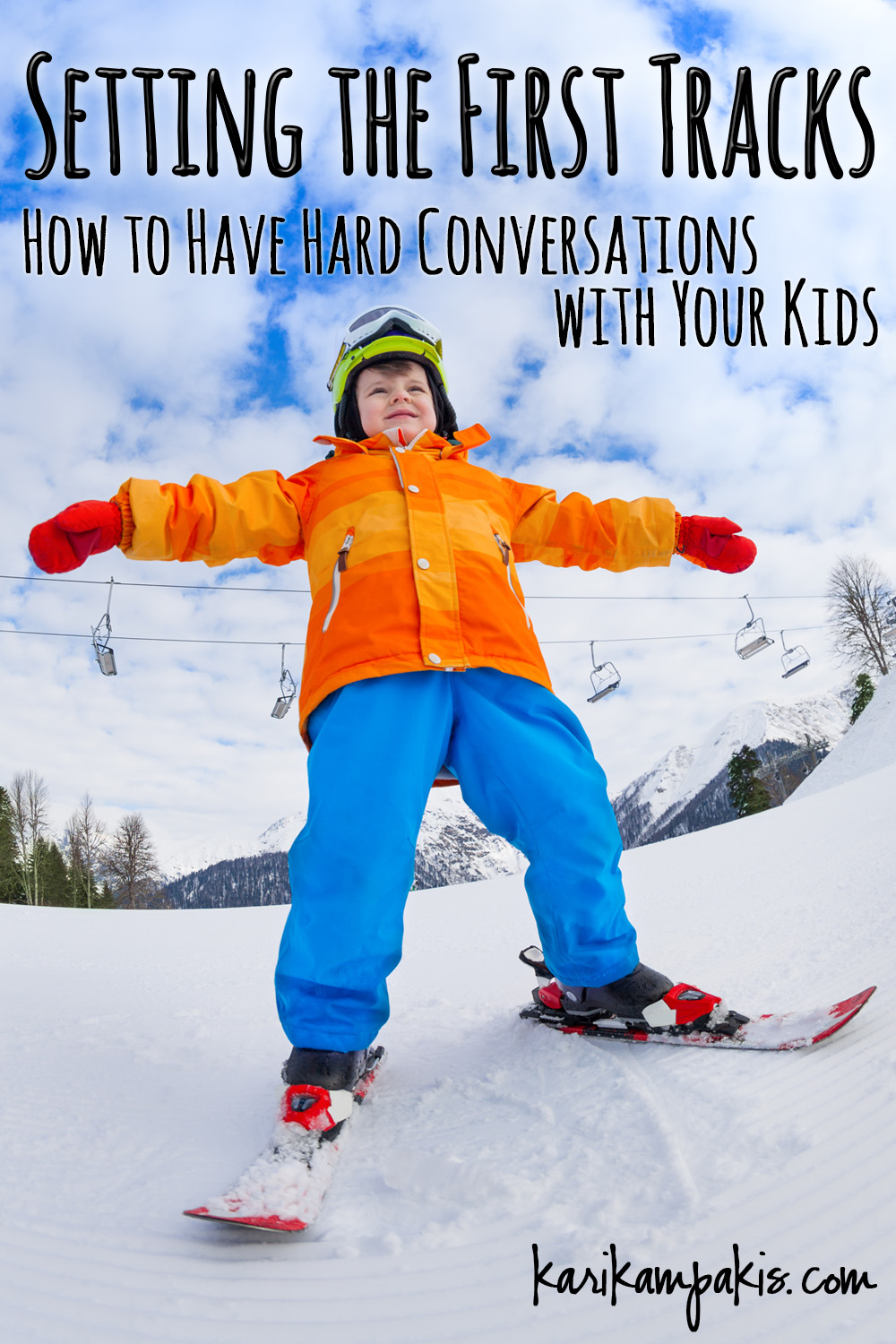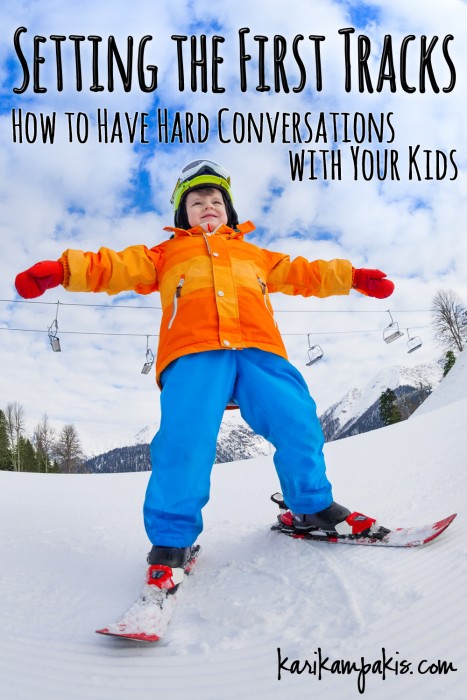Setting the First Tracks: How to Have Hard Conversations with Your Kids

Imagine your child at the top of a ski slope. They’re about to ski down for their first time, but for now, they’re relishing the view.
A blanket of snow just fell, so the view is fresh and pure. The fluffy white snow is completely blemish-free. It’s a wondrous sight, but it’s temporary. Because pretty soon, skiers will start sailing down this hill. Each one will set tracks in the snow that impact your child’s perspective.
Whoever skis down first, setting the first tracks in the snow, will leave a particularly deep impression because chances are, your child will remember it.
This ski slope is a lot like your child’s mind. And as parents, we instinctively protect their mind. We keep our kids in safe environments and guard their innocence to the best of our ability.
And though this is a great instinct, we must remember that our kids will be exposed to things sooner than we tend to believe. In mere seconds, their pristine view of the world can be interrupted by a peer, a Google search, or some random event that leaves a negative mark.
“Setting the first tracks” is a term that Gil Kracke, a counselor at Covenant Counseling and the Church of the Advent in Birmingham, uses to encourage parents to have those uncomfortable yet necessary conversations. As parents, we want to set the first tracks. We want to ski down first and impress the truth in our kids’ minds so that when other skiers come behind us, our kids know which tracks to trust.
Establishing ourselves upfront as the authority helps us become our child’s go-to person. It lets them know they can come to us with questions to help them discern which tracks in the snow are healthy and right – and which ones aren’t.
But how do we begin these awkward conversations? How do we talk about things we’d rather not talk about, like our child’s body, pornography, and other hard realities?
According to David Thomas, a counselor with DayStar Counseling in Nashville, and author of the book Wild Things, parents should get in front of the issues. David suggests that we talk about things before an event ever happens.
Gone are the days of a single “Birds and the Bees” talk. Instead of a one-time conversation, there should be ongoing dialogue. Parents should create a safe space where kids feel comfortable opening up and asking the questions they’ll inevitably take somewhere – if not to us, then to a friend or Google.
Here are 8 guidelines David offers to help parents create a safe environment that encourages openness and honesty.
1. Start early. Between ages 3-5, we can begin conversations with our kids about their bodies. David recommends a 4-book series called God’s Design for Sex to familiarize kids with the language and get them comfortable talking about it.
2. Be the first and best source of information. To be our child’s go-to person, we should communicate a sense of safety so they instinctively come to us when they want information. Our kids read us, and if we look or act awkward, they’ll quit talking. For this reason, we need to be familiar with the realities of their world (current and what’s to come) and comfortable talking about them. Otherwise they won’t feel safe to keep asking questions.
3. Use anatomically correct words when talking about the body.
4. Invite questions. One way to encourage conversation is to tell our kids, “I’m so glad you asked me that. Anything else you want to ask?” Or, we can ask them questions like, “What were you thinking when you heard that?” Oftentimes, helping our kids think through a situation can help them form their own conclusions.
5. Revisit the conversation often. Upfront our kids should hear, “We’re going to come in and out of this conversation your whole life. It’s not a one-time thing, but rather an ongoing healthy discussion.” To keep the talks informal and non-threatening, David suggests an occasional “Dude’s Weekend” or “Girl’s Night.” You can spend the night at a hotel, for instance, and weave the dialogue into fun experiences like letting your child swim, eat pizza, and watch a movie.
6. Stay a step ahead of his/her development. We shouldn’t wait until our child hits puberty to discuss puberty. Kids need to hear “You are normal,” and when we prepare them for what’s to come, they don’t panic over the changes they experience because they know what to expect.
7. Put it in a physical and spiritual context. Sex within the context of marriage is a gift from God, and the last thing we want to do is make our kids ashamed of their sexuality. It’s important for them to know their bodies are holy and good, and their journey to manhood/womanhood is part of God’s plan. It’s when we use our bodies and sex in ways God never intended that problems occur. While our world glamorizes the idea of sex outside of marriage, the truth is, it leads to a lot of pain and regret.
8. Find books to read together. Books can be helpful in opening the door to hard conversations. Remember, however, that books should be used to facilitate conversation, not replace it.
And what if you aren’t your child’s first memory? What if that kid from school who likes to educate all the other kids on nitty-gritty topics beats you in setting the first tracks?
If that’s the case, don’t worry, because it’s never too late to start talking. Even if you aren’t your child’s first memory, you can be most of their memories.
The hard conversations take courage, and trust me, I know how uncomfortable they can be. What helps me stay brave is remembering what a middle school counselor once told me about parents who have open dialogue versus parents who think they’re “protecting” their kids by not addressing hard realities.
“Parents who have the hard conversations are much more likely to have their kids open up and tell them what’s really going on,” she said. “Parents who don’t have those conversations are less likely to have their kids open up because the kids know their parents will freak.”
In short, our kids need us speaking truth into their lives. They need guidance to help them discern which tracks in the snow are worth paying attention to – and which ones aren’t.
And by making hard conversations a normal part of our family life, we can gradually get past the awkwardness. We can develop stronger relationships that allow us access into our children’s world and open up our eyes, minds, and hearts to the realities they face now and will continue to face in the winding road ahead.
******************************************************************************************************************************
Thanks for reading this article today. If you found the message helpful, please share it through social media.
I’m grateful for my readers and would love to connect. You can subscribe to my blog, join my Facebook community, or find me on Instagram, Twitter, or Pinterest.
Also, I’ve written two books for teen & tween girls designed to empower them through faith. The newest one, Liked, is getting a fantastic response as a unique resource for girls of the digital age, and along with the bestselling 10 Ultimate Truths Girls Should Know, it’s being used widely across the U.S. for small group studies.
Have a great day, and thanks again for stopping by!
Posted by Kari on February 7, 2016








How do you have these hard conversations when your 6th grader will not let you talk about any of these topics? She just shuts it down or sticks her fingers in her ears.
I know the feeling! I had one child who told me she wanted to be blindfolded when I started this conversation, and I told her I wanted to blindfolded too:)
A few things to consider: keep it matter of fact and inject some humor where possible; give her a head’s up, telling her you’re going to start these conversations and it will be awkward at first – for her and you – but as time goes on, they will feel more natural; cover one subject at a time so she’s getting the talks in small doses, not overloaded at once; use car time to talk because you’re not facing each other and that makes it less awkward automatically; and know what you want to say, and then look for opportunities to bring that subject up.
For example, when there’s a news story on pornography, you can lead with that, and then have a conversation and sharing the truth.
You can do it, just be strong and have your thoughts together before you start. Most kids will not go to their parents to initiate these conversations, and that keeps me prompted to be the initiator. I have learned that it gets much easier with practice. Also, pray beforehand for God to give you the words and grace. You’re a good mama and your daughter is lucky that you care enough to do this hard thing!!